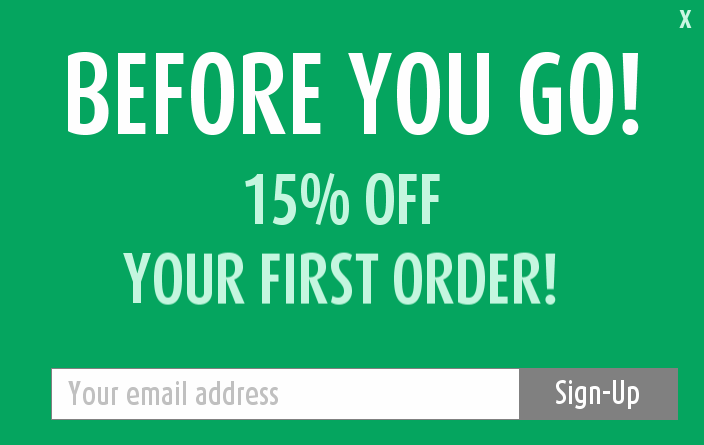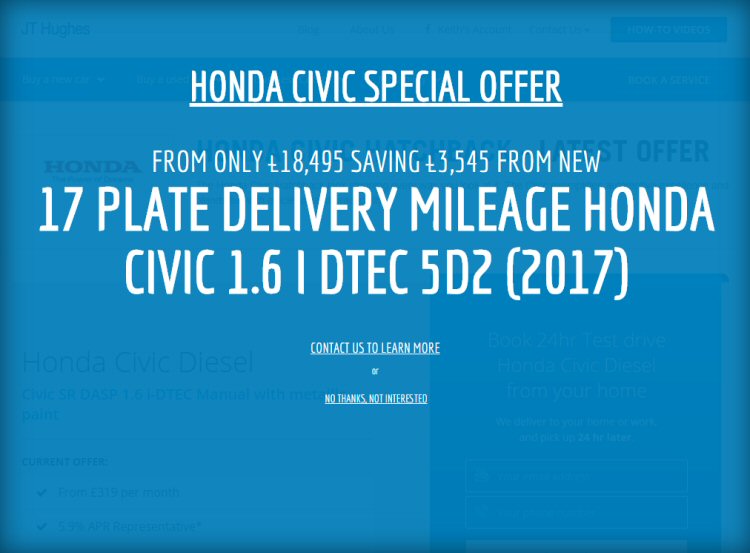Fact – a large proportion of website visitors will leave a website without engaging in any way. Depending on the nature of your content and website, as much as 90% of your visitors will land on a page and then abandon your site without purchasing, enquiring or connecting in any way.
This is mostly due to our human tendency to lose or shift interest very quickly as we browse online. Any improvement that can catch the attention of these abandoning visitors at the right time is likely to improve conversion and help you connect with more potential customers. This is where Exit Intent Campaigns can help.
How Does Exit Intent Work?
Exit Intent is a technology that runs within the visitor’s web browser and detects the precise moment a visitor is about to leave your website. It then triggers a pop-up or screen takeover banner catching the user’s attention. The detection uses a combination of factors such as the tracking of the mouse cursor as it moves to leave the page, such as to switch to a different tab.
Designing Exit Intent Campaigns
Campaigns designed for use with Exit Intent technology should be designed specifically to recover abandoning potential customers. These should use short but strong messaging that offers a last-chance conversion option to visitors. “Before Your Go” and “Don’t Leave Before You Check This” titles are often used to signal an offer that is relevant to the customer’s interests. The campaign may also contain context sensitive content such as offers that refer to the product shown on the page. The campaign should also provide a CTA (Call To Action), button or link to lead an interested customer to engage – such as an enquiry form or a subscribe option.

Customer Segmentation
A little research into the type of visitors on your website and your target customer groups will provide the key data you will need to create campaigns that are specifically tuned to the interests of your customers and further help you improve conversion on your website. For example, a shopping website could use shopping cart data to provide “just-in-time” offers to customers on products that are on their wish-list. You may build further on this to create unique sets of offers and promotions that target your different customers. The Exit Intent system will then display the right message to each audience to achieve maximum impact.
Here is an example: A smart exit intent campaign may target customers looking at a new product to highlight an offer for purchasing the same product as “used”. Exit Intent campaigns can be a great cross-selling technique.
A/B Testing
Testing different running campaigns will enable you to figure out what works best for your business and what produces the best results. A/B testing allows you to run multiple variants of your campaigns side by side and monitor conversion stats to identify the best performers.
Tip: Small differences between ads can mean a lot to performance and conversion. Try the same ads using different colours or wording to find out what works best with your customers.

Targeting
Designing and running exit intent campaign across your website will help you recover a number of “lost” opportunities, however you will find that the best results can be obtained by designing campaigns around specific key pages, such as a product page or blog article. Making the exit offer relevant to the specific page makes it stand out to the customer and makes it a more effective CTA, that can convert into a sale or other engagement.
Example: An exit intent campaign could invite visitors to subscribe to follow articles on the same topic as the current page making your offer relevant and timely.
Geo Targeting
One way to target customers is to make use of Geo IP information to determine the country of origin of each visitor. This enables you to push tailored messages and content that are relevant to your customers in the different, such as using differnent languages.
Analytics
Exit intent performance metrics include views and conversions. These will provide you with a measurable and comparable report on the effectiveness of each of your campaigns. Exit Intent campaigns may be directly viewed and reported in Google Analytics for a seamless view of your online activity.

Best Practices
Here are a few ground rules will help you get your exit intent campaign right:
Include a call to action. A campaign must always provide an action for the customer to engage.
A discount or offer is an obvious start for a campaign, however sometimes a customer only needs some reassurance before making a purchase, such as a testimonial or even a support line.
Engagement by the customer may be reinforced with an instant action such as a thank you email, a download or instant voucher code.
Do not over do it. Exit Intent campaigns are great at catching the attention of visitors, but can quickly turn into a nuisance, negatively effecting your user experience. Typically, only show an exit intent popup once per visit / session.
Exit Intents are also effective post-purchase. These could be used for example to ask for feedback or a survey following a completed transaction.
Regular visitors may be targeted to highlight new products or related pages. This technique can help you cross-sell using exit intent campaigns even to existing customers.
Keep the graphical design of your campaigns simple and consistent with your website design. Customers will distrust popups that break away from the familiar layout and will prefer bold short clear messaging to the elaborate and fancy.
What’s In It For Me?
In summary, exit intent campaigns provide a last-chance opportunity to retain and convert an otherwise lost opportunity. Businesses may find different uses for such campaigns; however success will depend on catching the eye of a customer by making a relevant and compelling offer that is measurable and actionable.
Check out our Campaign Manager app, a tool designed to let you design and run Exit Intent campaigns on your website. It provides a wide range of functions that enable you to take control of your online messaging and target your customers effectively.
Learn more about Campaign Manager here.